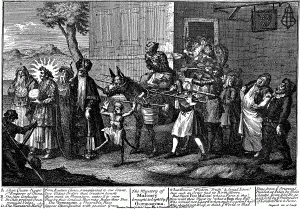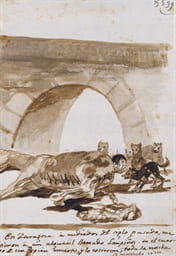Freemasonry and the Visual Arts Selected as a Choice Outstanding Academic Title for 2020
In addition, the book is one of five publications featured in a May 2021 posting by Choice highlighting Outstanding Academic Titles in the field of art: https://www.choice360.org/choice-pick/outstanding-academic-titles-2020-art-sculpture-photography/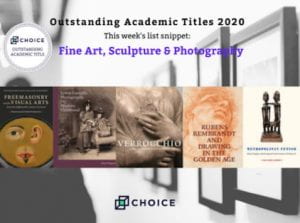
***
September 2020 Release
Freemasonry and the Visual Arts is now available in a paperback edition: https://www.bloomsbury.com/us/freemasonry-and-the-visual-arts-from-the-eighteenth-century-forward-9781501366925/
Click HERE for sample chapters of Freemasonry and the Visual Arts: Introduction and “Goya and Freemasonry”
From Reviews of Freemasonry and the Visual Arts:
“This book is a wonderful, detailed scholarly work…Preconceived ideas and inadequate existing scholarship are exposed on many levels…excellent introduction…an indispensable resource for scholars and students wishing to conduct further research into Freemasonry’s…influence…I thoroughly enjoyed this book.” –Robert Maddox-Harte, Leonardo Reviews, October 2020
A “fascinating and illuminating book.” –David M. Sokol, Journal of American Culture, September 2020
A “beautifully produced collection” with a “comprehensive introduction” and “covering an impressive range of arts…Highly recommended.” –M. Latzer, CHOICE (American Library Association publication), July 2020
Freemasonry and the Visual Arts “brings new perspectives to Freemasonry’s impact on wider culture.” –Daniel Gardiner, Scottish Rite Journal, March-April 2020
NOVEMBER 2019 PUBLICATION
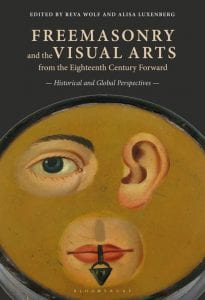 Freemasonry and the Visual Arts from the Eighteenth Century Forward: Historical and Global Perspectives
Freemasonry and the Visual Arts from the Eighteenth Century Forward: Historical and Global Perspectives
Co-Edited by Reva Wolf and Alisa Luxenberg
With the dramatic rise of Freemasonry in the eighteenth century, art played a fundamental role in its practice, rhetoric, and global dissemination, while Freemasonry, in turn, directly influenced developments in art. This mutually enhancing relationship has only recently begun to receive its due. The vilification of Masons, and their own secretive practices, have hampered critical study and interpretation. As perceptions change, and as masonic archives and institutions begin opening to the public, the time is ripe for a fresh consideration of the interconnections between Freemasonry and the visual arts. This volume offers diverse approaches, and explores the challenges inherent to the subject, through a series of eye-opening case studies that reveal new dimensions of well-known artists such as Francisco de Goya and John Singleton Copley, and important collectors and entrepreneurs, including Arturo Alfonso Schomburg and Baron Taylor. Individual essays take readers to various countries within Europe and to America, Iran, India, and Haiti. The kinds of art analyzed are remarkably wide-ranging-porcelain, architecture, posters, prints, photography, painting, sculpture, metalwork, and more-and offer a clear picture of the international scope of the relationships between Freemasonry and art and their significance for the history of modern social life, politics, and spiritual practices. In examining this topic broadly yet deeply, Freemasonry and the Visual Arts sets a standard for serious study of the subject and suggests new avenues of investigation in this fascinating emerging field.
Table of contents
Acknowledgments
List of illustrations
Introduction: The Mystery of Masonry Brought to Light
Reva Wolf and Alisa Luxenberg
1. Freemasonry in Eighteenth-Century Portugal and the Architectural Projects of the Marquis of Pombal
David Martín López
2. The Order of the Pug and Meissen Porcelain: Myth and History
Cordula Bischoff
3. Goya and Freemasonry: Travels, Letters, Friends
Reva Wolf
4. Freemasonry’s “Living Stones” and the Boston Portraiture of John Singleton Copley
David Bjelajac
5. The Visual Arts of Freemasonry as Practiced “Within the Compass of Good Citizens” by Paul Revere
Nan Wolverton
6. Building Codes for Masonic Viewers in Baron Taylor’s Voyages pittoresques et romantiques dans l’ancienne France
Alisa Luxenberg
7. Freemasonry and the Architecture of the Persian Revival, 1843-1933
Talinn Grigor
8. Solomon’s Temple in America: Masonic Architecture, Biblical Imagery, and Popular Culture, 1865-1930
William D. Moore
9. Freemasonry and the Art Workers’ Guild: The Arts Lodge No. 2751, 1899-1935
Martin Cherry
10. Picturing Black Freemasons from Emancipation to the 1990s
Cheryl Finley and Deborah Willis
11. Saint Jean Baptiste, Haitian Vodou, and the Masonic Imaginary
Katherine Smith
Selected Bibliography
Index
Reviews posted on the Bloomsbury Academic website:
“Explicating the vast network of interconnections between Freemasonry and the visual arts in multiple societies from the 18th century onward, this book is an invaluable resource of information and analysis. Wolf and Luxenberg have gathered a series of brilliantly insightful essays.” – Edward J. Sullivan, Helen Gould Shepard Professor of the History of Art, New York University, USA
“This is a much-needed book on an important subject. The links between freemasonry and the visual arts are many, but their scope has not been fully appreciated. Freemasonry and the Visual Arts from the Eighteenth Century Forward demonstrates how freemasonic symbols and ideas permeate a wide range of visual products, from architecture and urban planning to paintings and porcelain, and how freemasonry’s influence can be detected in settings far from the lodges themselves. The book presents a global perspective on its subject, offering essays on Portugal, Iran, and Haiti alongside the better-studied settings of Britain and the United States. It likewise offers models for analyzing fragmentary or hidden historical experiences. Freemasonry and the Visual Arts suggests that art offers opportunities to tap into histories that otherwise would remain lost to us.” – Michael Yonan, Professor of Art History, University of Missouri, USA
“The enormously rich visual culture generated by Freemasonry has not received the attention it deserves from art historians. This pioneering collection of essays provides fascinating and tantalising illustrations of the rich artistic legacy of Freemasonry in many different countries ranging from Europe and America to Haiti, Iran and India across media including paintings, prints, metalwork, jewellery, ceramics and architecture.” – Andrew Prescott, Professor of Digital Humanities, University of Glasgow, Scotland
***
Wolf spoke on work in progress about images of Inquisition punishments as they relate to the ideals and politics of eighteenth-century Freemasonry at three conferences in 2018-19:
The 15th international conference on Spanish Freemasonry, held at the Gulbenkian Foundation, Lisbon
The 8th annual UCLA conference on Freemasonry, “Diversity and Exclusivity in Eighteenth-Century Freemasonry”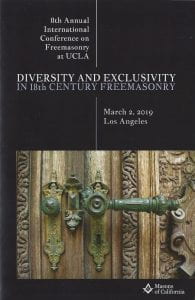
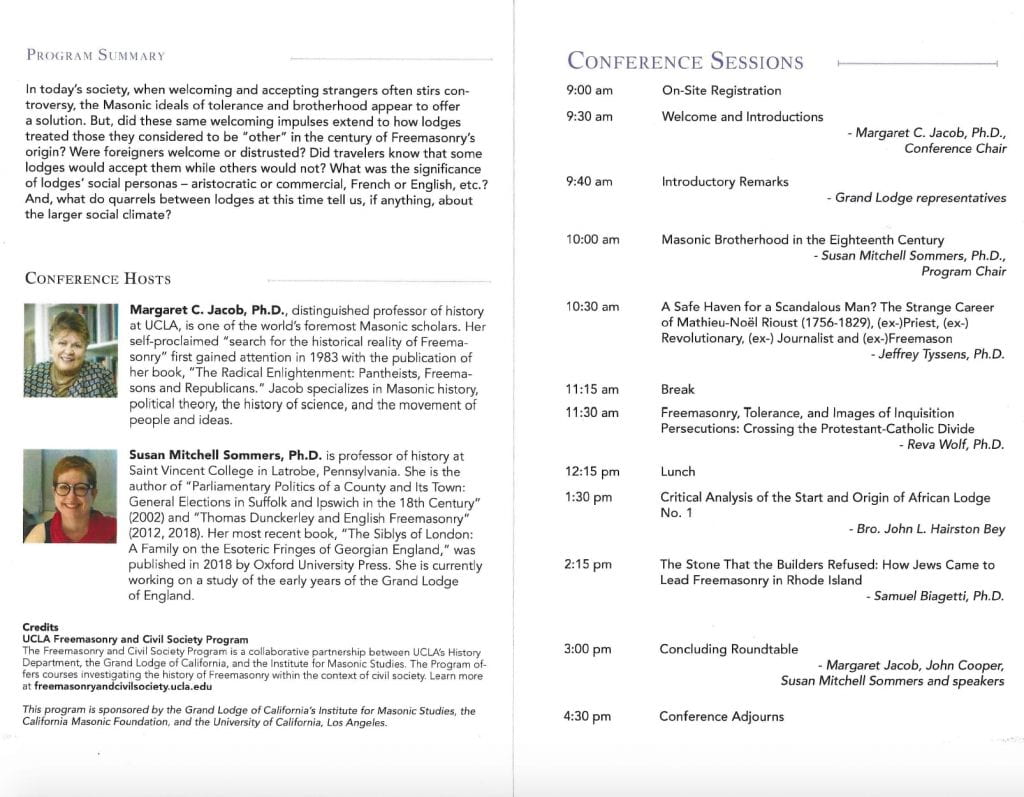 The Concluding Roundtable:
The Concluding Roundtable: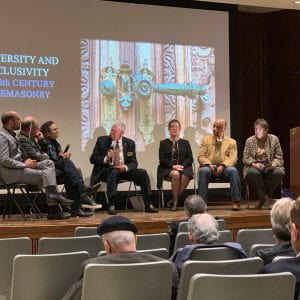
The annual conference of the American Society for Eighteenth-Century Studies (ASECS), in Denver, in a panel on the “Black Legend”
***
Reva Wolf gave three talks in spring 2016 related to new research projects:
She presented “Cosmic Jokes and Tangerine Flake: Translating Andy Warhol’s POPism,” a collaboration with Kou Huaiyu of Beijing, the translator of POPism into Mandarin, in the symposium Complementary Modernisms in China and the U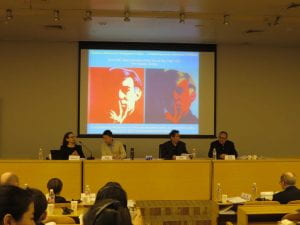 .S.: Art as Life/Art as Idea, held at the China Academy of Art, Hangzhou, March 24-26. The focus of the talk was on the challenges of translating Warhol and Pat Hackett’s book, which is littered with colloquialisms and time-specific terms. Wolf also considered how the translation of POPism into Mandarin fits into the broader history of translating Warhol’s publications into other languages. The Complementary Modernisms symposium brought together scholars from China and the U.S. for three days of exciting and fruitful discussion, discovery, and debate. The symposium was organized by Bruce Robertson, University of California, Santa Barbara, and Zhang Jian, China Academy of Art, Hangzhou.
.S.: Art as Life/Art as Idea, held at the China Academy of Art, Hangzhou, March 24-26. The focus of the talk was on the challenges of translating Warhol and Pat Hackett’s book, which is littered with colloquialisms and time-specific terms. Wolf also considered how the translation of POPism into Mandarin fits into the broader history of translating Warhol’s publications into other languages. The Complementary Modernisms symposium brought together scholars from China and the U.S. for three days of exciting and fruitful discussion, discovery, and debate. The symposium was organized by Bruce Robertson, University of California, Santa Barbara, and Zhang Jian, China Academy of Art, Hangzhou.

Participants in the Complementary Modernisms symposium, Hangzhou, China Academy of Art, March 24, 2016
Along with the sponsorship of the University of California and the China Academy of Art, the symposium received generous support from the Terra Foundation for American Art.
Wolf also presented some of her preliminary research on Freemasonry and visual art at two conferences. In February, she introduced and chaired the session “The Mystery of Masonry Brought to Light: Freemasonry and the Visual Arts from the Eighteenth Century to Now” at the 104th annual national conference of the College Art Association (CAA), held in Washington, D.C. Two primary aims of this session, which Wolf organized, were to show the important links between Freemasonry and art from the eighteenth century forward, and to reveal the global reach of these links. In March, Wolf gave a talk on Francisco de Goya and Freemasonry in the panel “Eighteenth-Century Freemasonry and the Arts” at the American Society for Eighteenth-Century Studies (ASECS) annual meeting in Pittsburgh. This panel, organized by the musicologist Rebecca Dowd Geoffroy-Schwinden, was productive in revealing cross-currents and parallel themes in masonic symbolism and networking activities within the worlds of music and visual art.
**********
Following is a miscellany of some of Reva Wolf’s other recent and past research activities and publications.
* “Folly, Magic and Music in Goya’s Album D” is an essay for the catalogue of a major exhibition, organized by the Goya scholar Juliet Wilson-Bareau and the Courtauld Gallery  curator Stephanie Buck, that brings together all the known drawings, now scattered among many collections, from one of Goya’s albums (Goya: The Witches and Old Women Album, published by the Courtauld Gallery, in association with Paul Holberton Publishing, London, 2015). The essay proposes, among other things, that several drawings in Album D allude to works of Spanish or even Northern European literature that had been censored by and/or critical of the Inquisition: La Celestina, Fray Gerundio, a famous account of an Inquisition proceeding, Erasmus’s Praise of Folly. All this, at a time–the first three decades of the nineteenth century–when dramatic political upheaval within Spain led to a series of short-lived terminations of the Inquisition, at which moments previously censored writings were published. The moving, at times disturbing, drawings of Album D reflect a period of upheaval not unlike our own time.
curator Stephanie Buck, that brings together all the known drawings, now scattered among many collections, from one of Goya’s albums (Goya: The Witches and Old Women Album, published by the Courtauld Gallery, in association with Paul Holberton Publishing, London, 2015). The essay proposes, among other things, that several drawings in Album D allude to works of Spanish or even Northern European literature that had been censored by and/or critical of the Inquisition: La Celestina, Fray Gerundio, a famous account of an Inquisition proceeding, Erasmus’s Praise of Folly. All this, at a time–the first three decades of the nineteenth century–when dramatic political upheaval within Spain led to a series of short-lived terminations of the Inquisition, at which moments previously censored writings were published. The moving, at times disturbing, drawings of Album D reflect a period of upheaval not unlike our own time.
* The essay “Seeing Satire in the Peepshow,” in the volume Seeing Satire in the Eighteenth Century, edited by Elizabeth Mansfield and Kelly Malone and published in 2013 by SVEC  (Studies on Voltaire and the Eighteenth Century), Voltaire Foundation, University of Oxford, concerns the eighteenth- and early nineteenth-century equation of peepshows with satire. It considers representations of peepshows from throughout Europe, but focuses especially on a drawing by Francisco de Goya, Tuti li mundi, now in the collection of the Hispanic Society of America. The subject of “Seeing Satire in the Peepshow” developed out of Wolf’s previous research on Goya’s peepshow drawing for the catalogue of the exhibition The Spanish Manner: Drawings from Ribera to Goya, co-authored with Jonathan Brown, Lisa A. Banner, Andrew Schulz, and others (The Frick Collection, NY, 2010). Wolf also spoke on peephow imagery in Fall 2012 at the sixth annual Dennis O’Keefe Memorial Lecture, sponsored by the Friends of Sojourner Truth Library at the State University of New York at New Paltz (Seeing Satire, O’Keefe Lecture, Fall 2012, Poster). For more information on Seeing Satire in the Eighteenth Century, click here: SVEC_PS_02_13-Seeing Satire Announcement.
(Studies on Voltaire and the Eighteenth Century), Voltaire Foundation, University of Oxford, concerns the eighteenth- and early nineteenth-century equation of peepshows with satire. It considers representations of peepshows from throughout Europe, but focuses especially on a drawing by Francisco de Goya, Tuti li mundi, now in the collection of the Hispanic Society of America. The subject of “Seeing Satire in the Peepshow” developed out of Wolf’s previous research on Goya’s peepshow drawing for the catalogue of the exhibition The Spanish Manner: Drawings from Ribera to Goya, co-authored with Jonathan Brown, Lisa A. Banner, Andrew Schulz, and others (The Frick Collection, NY, 2010). Wolf also spoke on peephow imagery in Fall 2012 at the sixth annual Dennis O’Keefe Memorial Lecture, sponsored by the Friends of Sojourner Truth Library at the State University of New York at New Paltz (Seeing Satire, O’Keefe Lecture, Fall 2012, Poster). For more information on Seeing Satire in the Eighteenth Century, click here: SVEC_PS_02_13-Seeing Satire Announcement.
* A paper about one of Goya’s many fascinating drawings, of a constable sewn inside a dead horse, was presented at a symposium on Spanish drawings, held at the Courtauld Institute in January 2012. The drawing is set in Zaragoza, according to the inscription accompanying it, and the paper concerns the significance of Goya’s exploration of specific places such as Zaragoza in this and several other drawings. Here are the symposium program and conference abstracts:
SpanishDrawings_14jan12_poster-2
SpanishDrawings_14jan12_AbstractsandBiogs
And here, the drawing:
This paper elaborates on an intriguingly close similarity between the subject of Goya’s drawing and an eighteenth-century anti-papal treatise. Wolf first published her findings on the links between drawing and treatise in the exhibition catalogue The Spanish Manner: Drawings from Ribera to Goya, mentioned above.
* How art moves from place to place, changing significance along the way, is the topic of a published essay on the provenance and reception of Goya’s famous portrait of the young boy, Manuel Osorio Manrique de Zúñiga, now housed at the Metropolitan Museum of Art. The essay was published in Art in Spain and the Hispanic World: Essays in Honor of Jonathan Brown, edited by Sarah Schroth and published by Paul Holberton, London.
 Here is a PDF of the essay: L1013_Wolf, Goya’s Red Boy, 144-173, FINALFINAL
Here is a PDF of the essay: L1013_Wolf, Goya’s Red Boy, 144-173, FINALFINAL
* The essay “Goya’s Red Boy,” in its focus on reception, is historiographical. Wolf’s interest in historiography also has led her to the work of the art historian George Kubler. She is currently studying Kubler’s understanding of the role of metaphor in the writing of art history, which is the topic of a paper she presented in September 2012 at the symposium “Systems of History: George Kubler’s Portuguese Plain Architecture,” held at the University of Coimbra, Portugal. The conference proceedings are available at: http://www.ces.uc.pt/publicacoes/cescontexto/cescontexto.php?col=debates&id=8350
* An article on the refreshingly sharp analysis of the question “what is art?” in an episode of the popular TV cartoon The Simpsons appeared in Art Journal: Homer Simpson as Outsider Artist, 2006.
* The first of several publications concerning Andy Warhol and his milieu is this article about a book Warhol created in collaboration with his painting assistant, the poet Gerard Malanga: Collaboration as Social Exchange, 1993. An extensive study of Warhol’s relations with poets, Andy Warhol, Poetry, and Gossip in the 1960s, followed in 1997. Warhol’s literary connections are the subject of an essay for the catalogue of the exhibition, Reading Andy Warhol, held in Fall 2013 at the Brandhorst Museum in Munich, Germany. English and German editions of the catalogue are available:

* Wolf’s innovative research on the history and interpretation of the artist interview was initiated in a panel that she organized for the College Art Association’s annual conference of 1996. This research culminated in three essays, the most notable of which is “Through the Looking-Glass,” focusing on Warhol’s interview strategies and serving as the introduction to I’ll Be Your Mirror: The Collected Andy Warhol Interviews (2004), edited by Kenneth Goldsmith. A Spanish translation, published by Blackie Books, appeared in 2010, an d a Russian translation was issued i
d a Russian translation was issued i n 2016 by the Garage publishing program, Moscow, in collaboration with Ad Marginem Press. Wolf’s work on the artist interview prefigures recent interest in this topic as evidenced by writings in the Fall 2005 issue of Art Journal and the March 2012 issue of Art Bulletin. In April 2013, she spoke on Warhol’s interviews as a participant in the symposium Paroles d’artistes at the Centre Georges Pompidou, Paris, organized by the Pompidou in association with l’Institut national d’histoire de l’art (INHA).
n 2016 by the Garage publishing program, Moscow, in collaboration with Ad Marginem Press. Wolf’s work on the artist interview prefigures recent interest in this topic as evidenced by writings in the Fall 2005 issue of Art Journal and the March 2012 issue of Art Bulletin. In April 2013, she spoke on Warhol’s interviews as a participant in the symposium Paroles d’artistes at the Centre Georges Pompidou, Paris, organized by the Pompidou in association with l’Institut national d’histoire de l’art (INHA).
* Ongoing work on the tricky questions of authorship that Warhol brilliantly raised in his art fits into a long-term exploration of what appropriation means in practice (not just in theory). Wolf recently explored this subject in a paper focusing on issues of authenticity, interpretation, and the market, presented at the Fall 2012 symposium of the Association of Historians of American Art. Also on this subject is an article about Ted Berrigan’s poetry and appropriation, for a special issue of the online journal Intervalles on the theme of transcription (Fall 2008-Winter 2009). The article focuses on a poem that Berrigan “transcribed” from a piece of literary criticism by John Ashbery.
Here is the article: Wolf, Essay on Ted Berrigan and Transcription.
* A related topic of continuing interest is word-image relations. Recent work on this topic includes a talk on Allen Ginsberg’s photographs, “Places, People, and Memories,” for the panel “Ginsberg across Media: Photography, Tape Recording, and Film,” held at Fales Library, New York University, and occasioned by the exhibition Beat Memories: The Photographs of Allen Ginsberg, on view in Spring 2013 at the Grey Art Gallery, NYU. A special focus of this talk is the significance of William Blake’s illuminated books as a model for Ginsberg’s photographs.
* Another study to link the eighteenth and twentieth centuries is a paper at a symposium held in 2006 to honor the art historian Robert Rosenblum, entitled “Tal para Qual,” comparing Goya and Warhol, as an homage to Rosenblum’s proclivity for cross-national and cross-century comparison. Here is a picture commemorating the symposium:
* A symposium also was held to honor another graduate school teacher, Jonathan Brown. Wolf introduced the morning session of this symposium: Brown Symposium, Morning Introduction, May 22, 2008. Again, the participants came together for a portrait:


